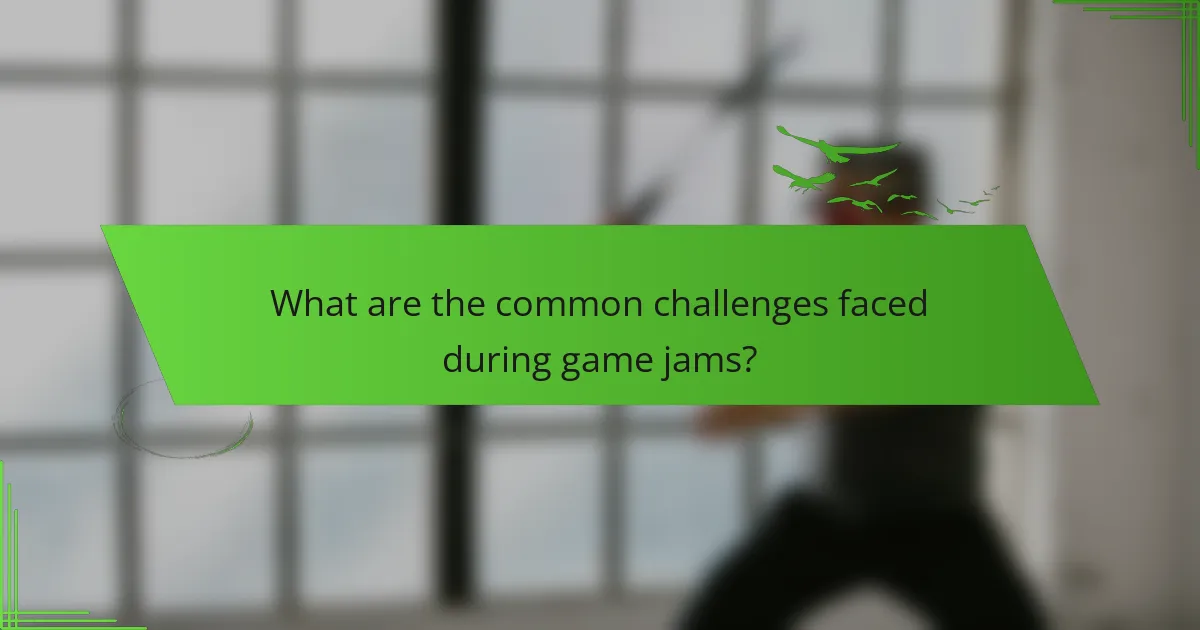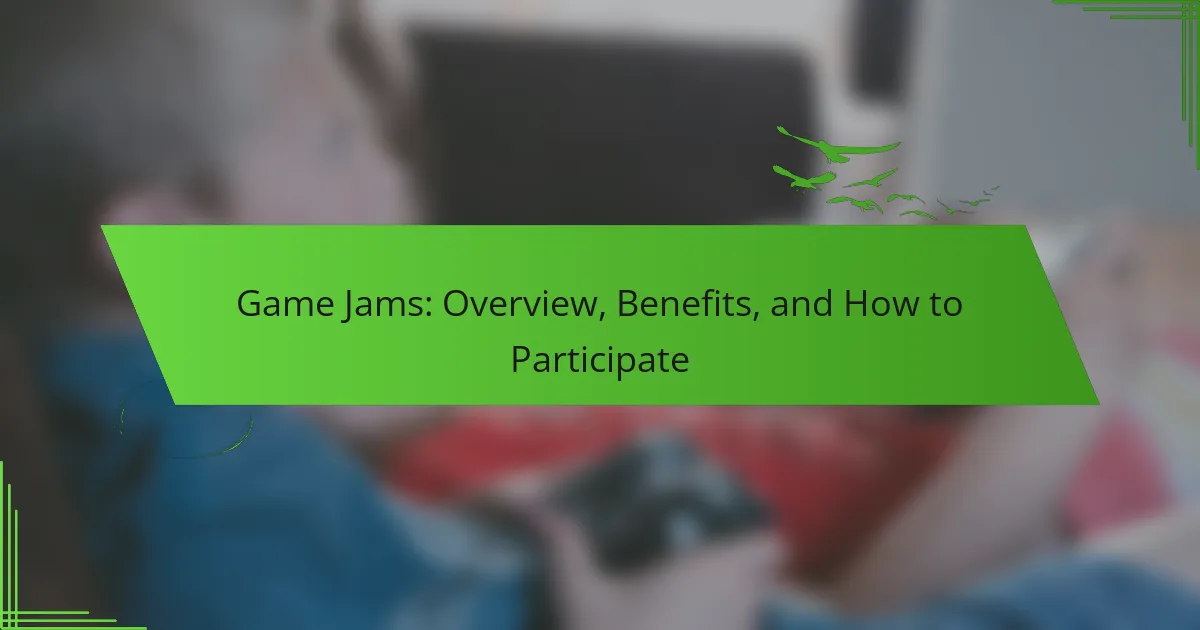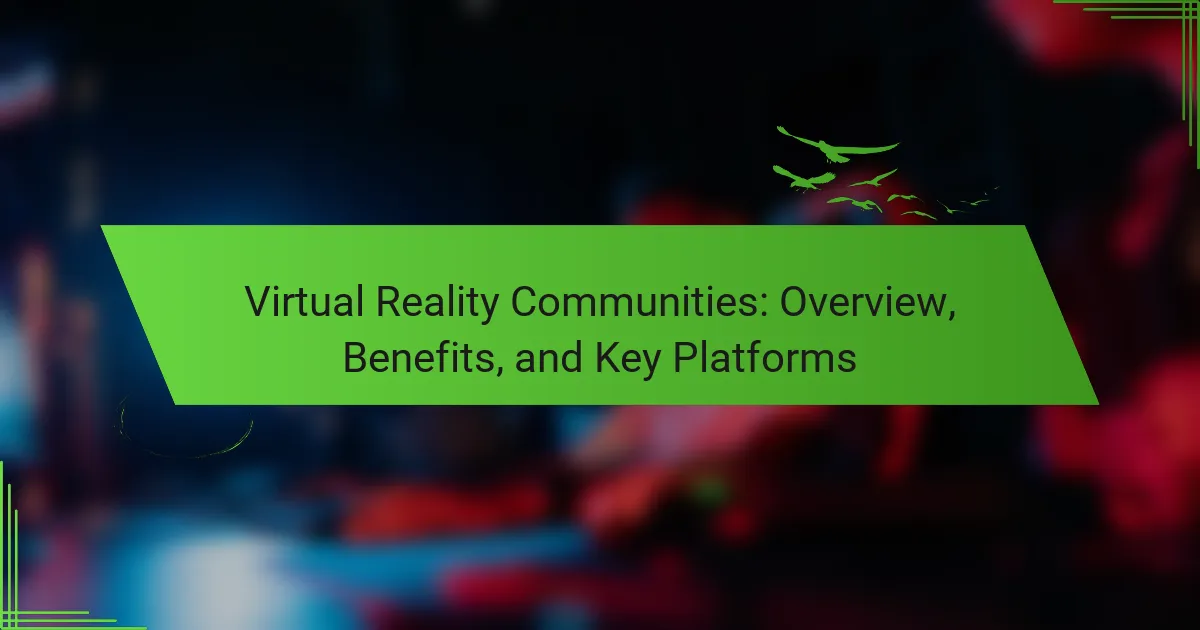Game jams offer a unique opportunity for creativity, collaboration, and skill development in game creation. Participants can enhance their teamwork abilities, tackle time constraints, and experiment with innovative ideas. This article explores the benefits of joining game jams, how to prepare effectively, and the cultural influences that shape these events. Additionally, it highlights successful projects that emerged from game jams, showcasing their impact on the gaming industry.

What are the core principles of game jams?
Game jams focus on collaboration, creativity, and rapid development to create games within a short timeframe. Key principles include time constraints, teamwork, and iterative design. Participants often explore innovative ideas, experiment with new technologies, and enhance their skills. Game jams foster community engagement and provide networking opportunities, which can lead to future collaborations.
How do game jams foster creativity and collaboration?
Game jams foster creativity and collaboration by providing a structured environment for rapid game development. Participants work in teams, encouraging idea sharing and diverse skill sets. The time constraints stimulate innovative solutions and experimentation with gameplay mechanics. Additionally, feedback from peers enhances the iterative design process, leading to improved final products.
Which platforms host the most popular game jams?
The most popular game jams are hosted on platforms like itch.io, Ludum Dare, Global Game Jam, GameMaker, and Unity. These platforms provide extensive resources and community engagement for participants.
Itch.io is known for its user-friendly interface and diverse game genres. Ludum Dare is famous for its long-standing tradition and competitive spirit. Global Game Jam connects developers worldwide, fostering collaboration. GameMaker offers tools and templates for easy game creation. Unity provides a robust engine for more advanced projects.

What benefits do participants gain from joining game jams?
Participants gain networking opportunities, skill development, and creative expression from joining game jams. These events foster collaboration among developers, artists, and designers, enhancing teamwork skills. Participants often create unique projects within tight deadlines, boosting their problem-solving abilities and adaptability. Additionally, game jams can lead to portfolio pieces, showcasing talent to potential employers.
How do game jams enhance skills and experience?
Game jams enhance skills and experience by providing hands-on opportunities for collaboration, creativity, and rapid problem-solving. Participants develop technical skills, learn project management, and gain exposure to diverse game development methodologies.
Through intense time constraints, participants improve their ability to work under pressure and adapt quickly to challenges. Networking with other developers fosters community engagement and potential future collaborations. Additionally, the iterative feedback process during game jams sharpens critical thinking and design skills, leading to personal growth and professional development.
What networking opportunities arise from participating in game jams?
Participating in game jams creates valuable networking opportunities with industry professionals, peers, and potential collaborators. Attendees can connect with game developers, artists, and designers, fostering relationships that may lead to future projects or job opportunities. Engaging in these events enhances visibility and builds a portfolio through collaborative work. Additionally, participants can receive feedback and mentorship, further enriching their professional network.

How can individuals prepare for a successful game jam experience?
To prepare for a successful game jam experience, individuals should focus on planning, collaboration, and skill development. Start by understanding the theme and requirements of the jam. Form a diverse team with complementary skills, including programming, design, and sound. Allocate time for brainstorming and prototyping ideas, ensuring everyone contributes. Familiarize yourself with necessary tools and software before the event to avoid technical issues. Lastly, maintain a positive mindset and embrace challenges as opportunities for learning and creativity.
Which tools and resources are essential for game jam participants?
Essential tools and resources for game jam participants include game engines, art software, collaboration platforms, and sound design tools. These resources enhance creativity and streamline the development process.
1. Game Engines: Unity, Unreal Engine, Godot
2. Art Software: Photoshop, GIMP, Aseprite
3. Collaboration Platforms: Discord, Slack, Trello
4. Sound Design Tools: Audacity, FL Studio, Bfxr
5. Documentation: Game Design Document templates, online tutorials
6. Asset Libraries: OpenGameArt, Kenney.nl, Unity Asset Store
What strategies can improve team collaboration during a game jam?
Effective strategies to enhance team collaboration during a game jam include clear communication, defined roles, and regular check-ins. Establishing a shared vision fosters unity and purpose. Utilizing collaborative tools, such as project management software, streamlines workflow and enhances coordination. Encouraging creativity through brainstorming sessions can lead to innovative ideas. Lastly, celebrating small wins boosts morale and keeps the team motivated.

What are the common challenges faced during game jams?
Game jams often face challenges such as time constraints, team dynamics, and technical limitations. Participants must manage limited hours to develop a game, which can lead to stress. Collaboration issues may arise from differing skill levels and communication styles. Additionally, technical hurdles, like software compatibility and hardware performance, can hinder progress. Balancing creativity with feasibility is crucial for success.
How can time management impact game jam outcomes?
Effective time management significantly enhances game jam outcomes by ensuring teams meet deadlines and allocate resources efficiently. Proper planning allows participants to focus on key tasks, fostering creativity and innovation. Additionally, good time management minimizes stress, leading to a more enjoyable experience and higher quality projects. Teams that prioritize time management often produce more polished games, increasing their chances of success in competitions.
What are typical technical issues encountered in game jams?
Game jams often face technical issues such as software compatibility problems, hardware limitations, network connectivity failures, and bugs in the game code. Participants may struggle with version control, leading to conflicts in collaborative projects. Additionally, time constraints can exacerbate these issues, limiting troubleshooting opportunities. Proper planning and testing can mitigate many of these challenges.

How do different cultures influence the nature of game jams?
Different cultures shape game jams by influencing themes, design styles, and collaboration methods. Cultural diversity enriches creativity and fosters unique gameplay experiences. For instance, Japanese game jams may emphasize storytelling, while Western jams often focus on mechanics. Additionally, local traditions and values can inspire game narratives and aesthetics, making each jam a reflection of its cultural context. This variation enhances participant engagement and broadens the appeal of games developed during these events.
What unique themes are prevalent in regional game jams?
Unique themes in regional game jams often reflect local culture, social issues, and community collaboration. These events encourage participants to explore specific narratives or gameplay mechanics that resonate with their environment. For instance, game jams in coastal regions might emphasize marine conservation, while urban areas may focus on city life challenges. Additionally, regional game jams frequently foster a sense of belonging, promoting teamwork and networking among local developers. This localized approach not only enhances creativity but also strengthens community ties through shared experiences in game development.
How do local communities support game jam events?
Local communities support game jam events by providing resources, venues, and networking opportunities. They often host workshops to enhance skills and promote collaboration among participants. Community engagement fosters creativity and innovation, enriching the overall experience. Additionally, local businesses may sponsor events, offering prizes or funding to encourage participation.

What are the most notable game jam success stories?
Game jams have led to numerous successful projects that gained popularity and recognition. Notable examples include “Superhot,” which originated from a game jam and became a critically acclaimed title. Another success story is “Celeste,” initially developed during a game jam, which later won multiple awards for its gameplay and storytelling. “Ludum Dare” has also spawned many successful games, showcasing the potential of rapid development. These stories highlight the creative opportunities and industry impact that game jams can foster.
Which games have emerged as standout titles from game jams?
Several standout titles have emerged from game jams, showcasing creativity and innovation. Notable examples include “Superhot,” which redefined time mechanics, and “Celeste,” celebrated for its platforming and narrative depth. Other significant titles are “Global Game Jam” entries like “A Game About Game Jam,” highlighting the unique experiences of game development. These games demonstrate the potential of game jams to foster new ideas and talent in the gaming industry.
What lessons can be learned from successful game jam projects?
Successful game jam projects teach valuable lessons about collaboration, creativity, and time management. Teams often learn to communicate effectively under pressure, fostering innovative ideas. Participants discover the importance of rapid prototyping, which enhances problem-solving skills. Additionally, embracing failure as a learning opportunity leads to improved resilience and adaptability in future projects.

What are the best practices for maximizing your game jam experience?
To maximize your game jam experience, focus on collaboration, time management, and clear communication. Engage with your team early to define roles and responsibilities. Set realistic goals and prioritize tasks to ensure progress. Participate actively in feedback sessions to refine your ideas. Embrace creativity and adaptability to overcome challenges.
How can participants effectively showcase their game jam projects?
Participants can effectively showcase their game jam projects by focusing on clear presentation and engaging storytelling. Highlight key features, gameplay mechanics, and unique aspects of the project. Use visuals like screenshots and videos to capture attention. Create a concise demo that showcases the gameplay experience. Engage with the audience through live demonstrations or Q&A sessions to foster interaction. Lastly, utilize social media and community platforms to share progress and gather feedback.
What common mistakes should participants avoid during game jams?
Participants should avoid common mistakes like over-scoping projects, neglecting team communication, and underestimating time management. Focusing on a manageable concept enhances creativity and collaboration. Prioritizing clear communication ensures everyone is aligned on goals. Proper time allocation prevents last-minute stress and promotes a polished final product.



